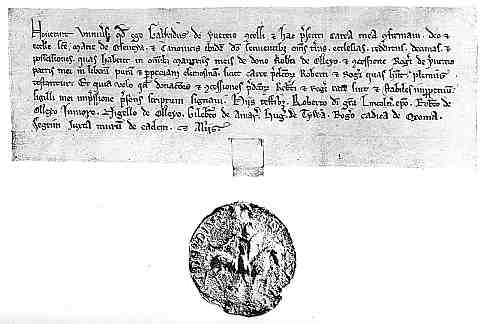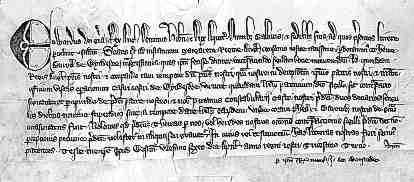

If you are looking at this page without frames, there is more information about medieval writing to be found by going to the home page (framed) or the site map (no frames).
| Forged Charters (3) | |
| It was not only royal charters that were forged. Private individuals had also made donations and bequests to religious institutions in the days before orderly written testimony, and these were also sometimes ratified by the beneficiaries with various degrees of creativity. | |
 |
|
| Forged charter of Oseney Abbey, from the Muniments of Christ Church College, Oxford. (From Salter 1929) | |
| The above example confirms to Oseney Abbey certain gifts given to the abbey by the father of the putative granter of this document. The charter is in the name of one Geoffrey de Ivri, a person who possibly did not even exist. The good monks apparently made themselves a copy of a seal of a person with a similar name. The charter refers to a certain Robert, bishop of Lincoln, who served in this position in the early 12th century. However, the exquisite ecclesiastical style Gothic script would seem to date from no earlier than the mid 13th century, and there are apparently numerous chronolical anomalies in the text which makes the scenario as they have depicted it impossible. Nevertheless, their bequest was ratified by a confirmation in writing, even if they not only wrote, but concocted it themselves. | |
| Although the disjunction of the Norman Conquest would seem to have made such processes particularly relevant for English institutions, forged charters are by no means confined to them. The process of transfer from oral testimony to written process was occurring over a large part of western Europe, and such documents have appeared from all over the area as part of the process of establishing the necessary archival ratification of church possessions. | |
 |
Letters patent of Edward I (Eton College Muniments, W.360). (From New Palaeographical Society 1909) |
| In 1305 the surveyor of Windsor Castle was accused of counterfeiting the seal of Henry III and falsifying letters patent from the king to obtain his position and a wage of 2d per day. Counterfeiting the royal seal was something that could be practised for petty fraud. What's more, he got off the hook. The document illustrated above is a pardon from Edward I for the offence. But everybody and his brother had a seal by then. | |
|
|
|
|
|
|
|
If you are looking at this page without frames, there is more information about medieval writing to be found by going to the home page (framed) or the site map (no frames). |
|